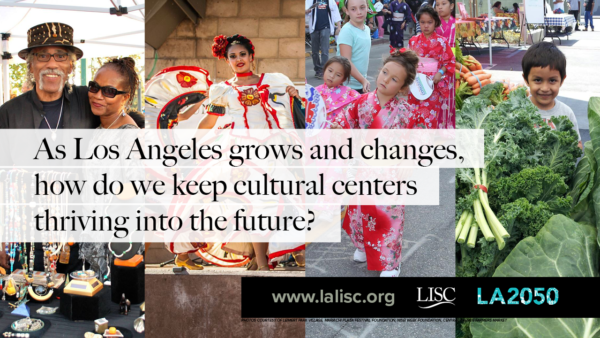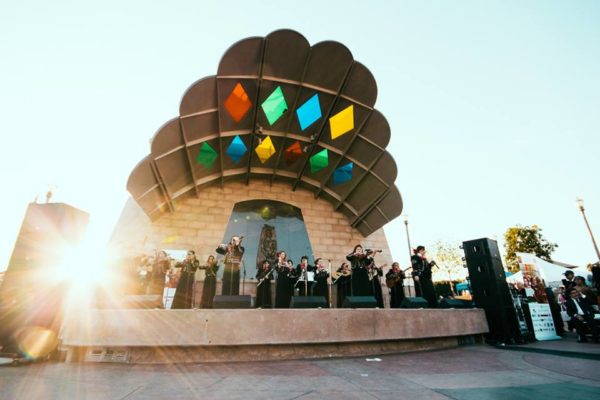Gentrification is a hot-button topic in Los Angeles, as it is in any number of cities. But debate around the issue tends to focus on residential displacement. Often lost in the conversation is what might be called “commercial gentrification.” This dimension of neighborhood disruption can be particularly devastating in a community with a distinctive ethnic and cultural identity. In such communities, small businesses and cultural establishments providing services specific to a shared history and heritage are an essential glue. Take them away and the neighborhood literally no longer smells, tastes or feels the same.
Tunua Thrash-Ntuk has been determined to grapple with this issue ever since she was a graduate student studying urban planning at MIT. She wanted to write a thesis about commercial gentrification but was initially told no such topic existed. She finally found a professor to support her inquiry and has been pursuing it ever since. At the West Angeles Community Development Corporation, she developed a community curriculum (a TOD or Transit-Oriented-Development University) to equip citizens with the knowledge and vocabulary to take ownership over the kind of rapid transformation a new train stop can bring to a neighborhood.
Now, as the executive director of the Los Angeles Local Initiatives Support Corporation (LISC), she is spearheading an ambitious proposal currently being considered in the My LA2050 Grant Challenge. At the heart of the proposal, Preserving LA’s Cultural Diversity is the idea of cultural entrepreneurship: leveraging culture as a tool for promoting sustainable neighborhood identities and economic development.
A Vision for LA in 2050
LA2050 is a project of the Goldhirsh Foundation, whose mission is to “connect the dots” between social innovations and the financial and human capital necessary to make them happen. Following an extensive process of surveys and community meetings, it issued a report codifying a broad set of goals designed to make Los Angeles the best place to Learn, Create, Play, Connect and Live. Starting in 2013, it has issued an annual call for innovative projects to move the city toward that shared vision—giving out a total of a million dollars each year.

This year, 289 proposals were submitted as of the October 4 deadline. During this week’s public voting period (which began Tuesday October 18 and runs through 5pm on October 25), any US citizen 14 years or older can vote online for one project in each of the five broad categories. A jury will select one proposal from the top vote-getters in each category, and then award additional grants based on merit and without regard to the popular vote.
Vital Cultural Corridors
“Preserving LA’s Cultural Diversity” targets four neighborhoods with a rich history and heritage: Leimert Park Village, the Central Avenue Historic District, Little Tokyo, and East Los Angeles / Boyle Heights. Each has struggled economically over the years, and each faces the particular challenge of dealing with transit-driven development and transformation that threatens to undermine its unique character and identity.
Leimert Park Village, for example, has for decades been a vibrant hub of African-American culture. (Filmmaker John Singleton calls it a kind of west coast “black Greenwich Village.”) Yet it has struggled to translate its considerable cultural capital into a sustainable economics. When Metro first announced plans for the Crenshaw-LAX transit line, local activists saw it as a chance to literally put the neighborhood on the map. They fought for, and won, a stop in the Village. But the victory appeared bittersweet as, within weeks of the station’s approval in May of 2013, a mystery developer bought up a number of storefronts on the east side of Degnan Boulevard. The mass evictions some feared did not take place, but it was a wake-up call: if future development was to be in keeping with the neighborhood’s unique cultural heritage, the Village was going to have to organize.
Thus was born the Leimert Park Village 2020 Vision Initiative, an alliance of business owners, artists and activists that has been meeting regularly at the neighborhood’s landmark Vision Theatre. The group won City approval of a People’s Street Plaza—a dedicated public space bridging the Vision and the neighboring park, and home to a monthly Art Walk and busy cultural calendar. It has engaged with the Urban Land Institute to identify ways of capturing the new markets the Metro stop will likely bring. But it is still short of the kind of capital, technical assistance and other resources Thrash-Ntuk’s proposal aims to provide.
Similarly, the Central Avenue Historic District, once the heart of an internationally renowned blues & jazz scene, has faced enormous demographic upheaval in recent decades. There, the Coalition for Responsible Community Development takes a youth-centered approach, assisting young people in pursuing education and identifying productive career pathways. At the northern end of Central Avenue is Little Tokyo, where the Little Tokyo Service Center collaborates to develop affordable housing and other community-building projects. Head east on First Street across the LA River and you’re in Boyle Heights, which has seen a good deal of strife over gentrification and related issues—including a showdown between Metro and local activists over the development of Mariachi Plaza. There and in neighboring East LA, the East Los Angeles Community Corporation pursues sustainable development around the guiding mission of “community wealth.”

Iconic Projects
A key step in Thrash-Ntuk’s proposal is the convening of a “cultural economic development summit” that would include the four targeted “magnet” neighborhoods, and other communities and commercial districts as well—from Cambodia Town in Long Beach, to Little Ethiopia, Koreatown, and Chinatown. All would benefit from exposure to models and tools that have been used successful both locally and nationally. LISC has been studying innovative “place-keeping” projects in Seattle and the Twin Cities, among other places.
Coming out of the summit, the four neighborhoods would each adopt and implement an “iconic” pilot project addressing both cultural and economic development. Leimert Park Village, for example, has been exploring the idea of a modular, neighborhood-based studio that would equip cultural establishments with the means to document its artistic heritage in word and sound and image, and form the basis of a sustainable, grassroots creative industry.
It’s ultimately all about capacity-building, Thrash-Ntuk says: giving communities the tools to control their economic destiny moving forward. While ownership is always ideal, there is a broad array of interventions to help local enterprises “anchor” themselves in the face of dramatic change, and then to effectively “capture” the very real opportunities that change presents. Something as simple as helping a restaurant negotiate the use of Yelp can be the difference between surviving, and not.
The stakes couldn’t be higher over the next few years, she says. The Harlem Renaissance, for instance, is a perfect example of the historic fragility of minority-owned cultural institutions, and the high social cost of failing to sustain them. This storied mecca of black writers, artists, musicians and scholars thrived during the 1920s and 30s, but lacked a sustainable economic base. Even its signature Apollo Theater fell into decline for many decades.
Thrash-Ntuk worries that some of LA’s defining “cultural pearls” could suffer the same fate if we ignore such cautionary histories. Unless communities are given the tools and resources they need to navigate demanding economic conditions, we might walk down their streets years later, with little more than a placard to remind us, “This once lived here.”
[alert type=alert-white ]Please consider making a tax-deductible donation now so we can keep publishing strong creative voices.[/alert]
Scott Doyle writes about business, community and the arts; and also writes fiction when he can find the time.
